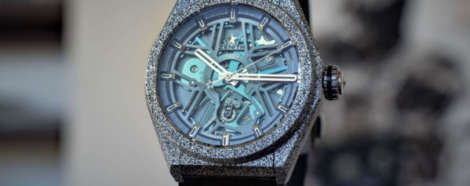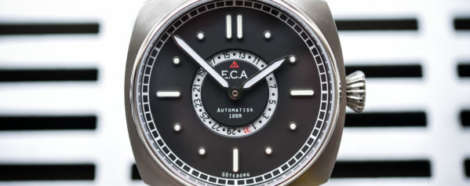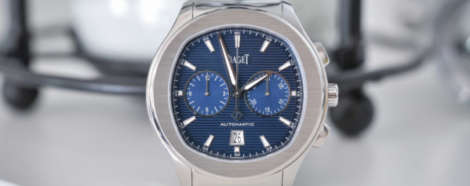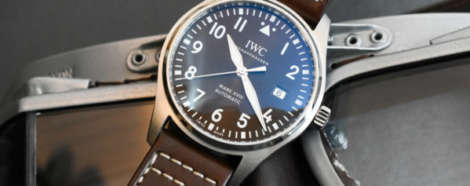In-Depth – Zenith DEFY LAB, 3 Centuries of Regulation & Chronometry Revolutionized with a Radically New Oscillator (Technical Insights & Video)
It’s now time to lift the veil on the big and truly exciting news we had anticipated further to Jean-Claude Biver’s (President of the LVMH watch division) and Julien Tornare’s (CEO of Zenith) press conference last May: a groundbreaking development in the field of chronometry, exploring unchartered territories and challenging the basic operating principle of the mechanical watch regulation, invented in 1675 by Christiaan Huygens – a principle that has remained basically unchanged since its creation. The name of this watch is the Zenith DEFY LAB, and it comes with a revolutionary, yet technically quite simple, type of oscillator.

 Twenty-five years ago Jaeger-LeCoultre released the Master Control collection, a line of watches dedicated to the sort of traditional high-quality watchmaking for which the Le Sentier-based house is so well known. The pure style of the Master Control sits well with the credibility afforded by JLC’s ‘1000 Hours Control’ testing program, in which the subject watch undergoes six weeks of extensive testing, covering off everything from accuracy to impact. And while these days this sort of rigorous testing procedure is increasingly par for the course, in 1992 JLC was well ahead of the pack. The potent combination of conservative good looks, horological credibility and a fair price meant that the Master Control collection has a well-earned reputation for offering exceptional quality. This year the offering only got better, as Jaeger-LeCoultre released a trio of anniversary watches with some pretty special vintage-inspired dials. The most simple of the three is the Master Control Date, followed by the more complicated Master Chronograph. Today, though, we’re going to look at the most complex offering of the three, the travel-oriented Master Geographic. Basically the Master Geographic is a dual-time watch with a city indicator. To me, the most remarkable achievement of the watch is how…
Twenty-five years ago Jaeger-LeCoultre released the Master Control collection, a line of watches dedicated to the sort of traditional high-quality watchmaking for which the Le Sentier-based house is so well known. The pure style of the Master Control sits well with the credibility afforded by JLC’s ‘1000 Hours Control’ testing program, in which the subject watch undergoes six weeks of extensive testing, covering off everything from accuracy to impact. And while these days this sort of rigorous testing procedure is increasingly par for the course, in 1992 JLC was well ahead of the pack. The potent combination of conservative good looks, horological credibility and a fair price meant that the Master Control collection has a well-earned reputation for offering exceptional quality. This year the offering only got better, as Jaeger-LeCoultre released a trio of anniversary watches with some pretty special vintage-inspired dials. The most simple of the three is the Master Control Date, followed by the more complicated Master Chronograph. Today, though, we’re going to look at the most complex offering of the three, the travel-oriented Master Geographic. Basically the Master Geographic is a dual-time watch with a city indicator. To me, the most remarkable achievement of the watch is how…

 This week on the wrist is borne almost purely out of curiosity. I have tried on Piaget Altiplano watches over the years and found them unusually comfortable to wear. In interviews and conversations with Altiplano owners, there’s always a resounding refrain of “it’s hard to go back to heavier/larger/thicker watches once you get used to it”. So, when given the chance to have an extended period of time with the Ultra-Thin date in rose gold, I jumped at it. My first impression was… That it’s a clean, deeply stylish statement, and that I might need a new wardrobe. A watch this slight and minimal seems to draw a lot more attention to the wrist, and the cuff, and the accessories that are being worn with it. While it’s saying very few words, they’re all well chosen, and they’re all expensive. Good luck dressing down this quiet achiever. Once I put it on, it felt… Hey, wait, is this thing actually on? Any heft you associate with gold does not exactly apply. While this Altiplano model is indeed pink gold, it is extremely light, and the comfort Altiplano wearers swear by is in full effect. Looks-wise… It’s minimal and mercurial. Having said that, it’s very…
This week on the wrist is borne almost purely out of curiosity. I have tried on Piaget Altiplano watches over the years and found them unusually comfortable to wear. In interviews and conversations with Altiplano owners, there’s always a resounding refrain of “it’s hard to go back to heavier/larger/thicker watches once you get used to it”. So, when given the chance to have an extended period of time with the Ultra-Thin date in rose gold, I jumped at it. My first impression was… That it’s a clean, deeply stylish statement, and that I might need a new wardrobe. A watch this slight and minimal seems to draw a lot more attention to the wrist, and the cuff, and the accessories that are being worn with it. While it’s saying very few words, they’re all well chosen, and they’re all expensive. Good luck dressing down this quiet achiever. Once I put it on, it felt… Hey, wait, is this thing actually on? Any heft you associate with gold does not exactly apply. While this Altiplano model is indeed pink gold, it is extremely light, and the comfort Altiplano wearers swear by is in full effect. Looks-wise… It’s minimal and mercurial. Having said that, it’s very…
 It’s hard to overstate the importance of Cartier’s Tank. Not just in the rarefied world of watch design, but in the much broader fields of fashion and design. In a crowded scene full of pretenders it stands out, like an enduring style icon in a room full of so-called influencers. This year the Tank celebrates its centenary, and Cartier has released a brace of new Tanks to mark the occasion, in the Française, Américaine, Cintrée and Louis Cartier collections. We’re going to look at the new steel Américaine shortly, but today we’re spending time with the most classical iteration, the large Tank Louis Cartier in pink gold. What you immediately notice about this Louis Cartier is just how little the design has changed since the Tank Louis Cartier was first introduced in 1922. Sure, little details such as the hands and Cartier text have changed, and the case construction is a little more sophisticated these days, but the fundamentals – the rectangular shape, softly curved case elements, Roman numerals and conical crown – are all the same. The second thing you will notice is the size. Under no circumstances could you accuse this Tank of wearing large, even though it’s the large-sized model,…
It’s hard to overstate the importance of Cartier’s Tank. Not just in the rarefied world of watch design, but in the much broader fields of fashion and design. In a crowded scene full of pretenders it stands out, like an enduring style icon in a room full of so-called influencers. This year the Tank celebrates its centenary, and Cartier has released a brace of new Tanks to mark the occasion, in the Française, Américaine, Cintrée and Louis Cartier collections. We’re going to look at the new steel Américaine shortly, but today we’re spending time with the most classical iteration, the large Tank Louis Cartier in pink gold. What you immediately notice about this Louis Cartier is just how little the design has changed since the Tank Louis Cartier was first introduced in 1922. Sure, little details such as the hands and Cartier text have changed, and the case construction is a little more sophisticated these days, but the fundamentals – the rectangular shape, softly curved case elements, Roman numerals and conical crown – are all the same. The second thing you will notice is the size. Under no circumstances could you accuse this Tank of wearing large, even though it’s the large-sized model,… There’s a running joke in the Time+Tide office about my proclivity for “beautiful blue” dials –I once managed to say it a few too many times in a short video review and, well, it sort of stuck. But in the case of this new version of the Jaeger-LeCoultre’s classic Master Ultra Thin Réserve de Marche the accolade beautiful blue is well and truly deserved. JLC specialise in ultra-thin watches, and this design of the Réserve de Marche has been a part of the collection since 2012. It is an exceptional, traditionally styled 39mm steel watch with a complicated-but-balanced dial layout consisting of a radial date at two and a power reserve (which gives the model its name) at 10. There’s a small seconds subdial at six that rounds off the dial. Few brands putting together a watch with this cocktail of complications would be able to pull it off with quite the degree of elegance that JLC manages. Partially this is down to the surprisingly restrained use of text on the dial, but mostly it’s because of the clarity of the design. The applied arrowhead markers and sharply faceted dauphine hands are perfect. However, there’s no doubt that the real star here…
There’s a running joke in the Time+Tide office about my proclivity for “beautiful blue” dials –I once managed to say it a few too many times in a short video review and, well, it sort of stuck. But in the case of this new version of the Jaeger-LeCoultre’s classic Master Ultra Thin Réserve de Marche the accolade beautiful blue is well and truly deserved. JLC specialise in ultra-thin watches, and this design of the Réserve de Marche has been a part of the collection since 2012. It is an exceptional, traditionally styled 39mm steel watch with a complicated-but-balanced dial layout consisting of a radial date at two and a power reserve (which gives the model its name) at 10. There’s a small seconds subdial at six that rounds off the dial. Few brands putting together a watch with this cocktail of complications would be able to pull it off with quite the degree of elegance that JLC manages. Partially this is down to the surprisingly restrained use of text on the dial, but mostly it’s because of the clarity of the design. The applied arrowhead markers and sharply faceted dauphine hands are perfect. However, there’s no doubt that the real star here… At some point on my watch journey, I made a resolution to resist all the shiny new things that get paraded in front of us daily and just start collecting the icons. The classics. The unquestioned cornerstones of modern watchmaking. Watches whose aesthetic, technological and for-the-good-of-humankind breakthroughs still resonate today. How’s that working out for me? Hmmm, there have been occasional slip-ups, and some redefinitions of what is “iconic” (Nomos makes modern classics, right?) but acquiring a TAG Heuer Monaco was to be a satisfying tick of the square-watch box. The only problem was, when I went to pull the trigger, there was an unexpected dilemma, a crossroads with two signposts – one pointing to a version powered by the Calibre 11 (reference CAW211P) and the other running off the Calibre 12 (reference CAW2111). Both have their merits, and both have a surprisingly legitimate connection to the original model, so which one would it be? The Calibre 12’s metallic starburst dial is more faithful to the very first blue-and-grey metallic dialled models in 1969. But the Calibre 11 is pretty much a dead ringer for the 1971 McQueen… decisions, decisions, decisions! I used the backdrop of the city of Monaco…
At some point on my watch journey, I made a resolution to resist all the shiny new things that get paraded in front of us daily and just start collecting the icons. The classics. The unquestioned cornerstones of modern watchmaking. Watches whose aesthetic, technological and for-the-good-of-humankind breakthroughs still resonate today. How’s that working out for me? Hmmm, there have been occasional slip-ups, and some redefinitions of what is “iconic” (Nomos makes modern classics, right?) but acquiring a TAG Heuer Monaco was to be a satisfying tick of the square-watch box. The only problem was, when I went to pull the trigger, there was an unexpected dilemma, a crossroads with two signposts – one pointing to a version powered by the Calibre 11 (reference CAW211P) and the other running off the Calibre 12 (reference CAW2111). Both have their merits, and both have a surprisingly legitimate connection to the original model, so which one would it be? The Calibre 12’s metallic starburst dial is more faithful to the very first blue-and-grey metallic dialled models in 1969. But the Calibre 11 is pretty much a dead ringer for the 1971 McQueen… decisions, decisions, decisions! I used the backdrop of the city of Monaco…